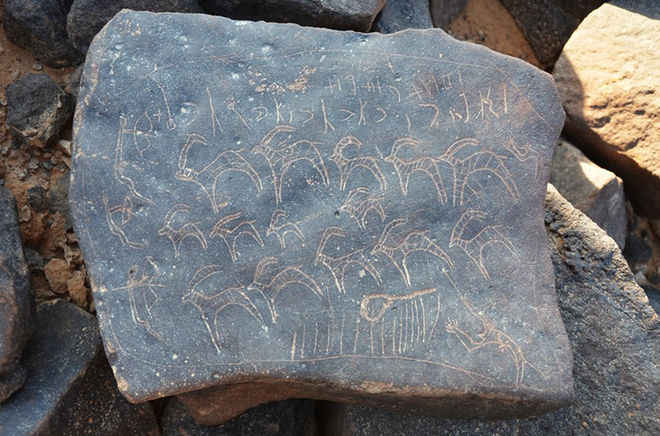“There are literally many thousands of Safaitic inscriptions and petroglyphs in the Jebel Qurma region, which suggests that people intensively used the area.” – Peter Akkermans, professor at Leiden University, Netherlands.

PHOTO: elitetourclub.com
Looking at the above picture, it’s hard to imagine that Jordan’s Black Desert once teemed with life. When we take a look at both the fossil and archaeological record, it’s clear that this arid stretch of land was once home to plants, animals, and a thriving human population.
Of course, that was 2,000 years ago.
“Nowadays, the Jebel Qurma area, and the Black Desert in general, is a highly inhospitable area, very arid and difficult to cross,” Professor Peter Akkermans, who leads the Jebel Qurma Archaeological Landscape Project, a project that is centered around uncovering the rich ancient history of Jordan’s Black Desert. The team working on the project has taken hundreds of pictures of the surrounding countryside, documenting literally thousands of 2,000-year-old inscriptions and petroglyphs carved into the desolate landscape.

PHOTO: livescience.com
The petroglyphs depict hundreds of creatures that are hard to imagine surviving in such a desert, creatures like lions, gazelles, horses, and even an unknown species of large bird. They tell a story of a landscape that was rich in natural resources, supporting a vast biological network of wildlife.
Of course, the archaeologists and researchers have found inscriptions paired with the rock art, too. Most of them are fairly rudimentary – just names of the people who created the carvings. However, some of them tell stories, stories of the everyday struggles of the people of Syria, Jordan, and ancient Arabia. One inscription is translated as, “May there be strength against hunger,” and another says “I am on the lookout for the Nabataeans,” – the ancient builders of the famous city of Petra.
The petroglyphs and inscriptions aren’t all the researchers found in the Black Desert. Petroglyphs and inscriptions alone don’t tell the story of human life in Jebel Qurma. They’ve also found the remains of shelters and tombs used by the ancient peoples. 2,000 years ago, the land was inhabited by a nomadic people that rode horses, hunted lions and large birds with bows and arrows and spears, and moved from place to place, leaving graves in their wake, hunting, and gathering.
Two-thousand years ago, the area of Jordan was home to not only a shifting physical landscape, but also a shifting social and political landscape. The nomadic peoples of Jordan and Syria were subject to the invading forces of the Roman Empire, then at its height and forming alliances with the Nabataeans, who we know from the inscriptions were not friendly with the local nomadic tribes.
As of yet, archaeologists and researchers still aren’t sure what caused this once lush area of Jordan to turn into a desert-wasteland. They’re searching for more environmental evidence of what the area used to look like two-thousand years ago, and what factors might have caused the land to dry up.
“Our excavation at one site revealed masses of charcoal from the third century A.D., which appeared to represent several taxa [groups] of trees, which needed water year-round,” Akkermans explained, “Hence, the conditions in at least the third century A.D. may have been quite different from today. This is certainly something I wish to explore in the next field seasons, by coring for pollen.”
Pollen cores work very similarly to rock cores, where archaeologists can create a map of the history of an area based on different layers in any given core. Using radiocarbon dating, they can figure out when each layer was laid down, and by sampling and analyzing the pollen cores, they can determine what plants grew at a specific point in time, and thus, what the climate was like.
The archaeologists are hoping to continue their research on the Black Desert area in Jordan. They recently published their study on the area’s history in the American Journal of Archaeology.

